10 francs FRANCE (1988-2001)
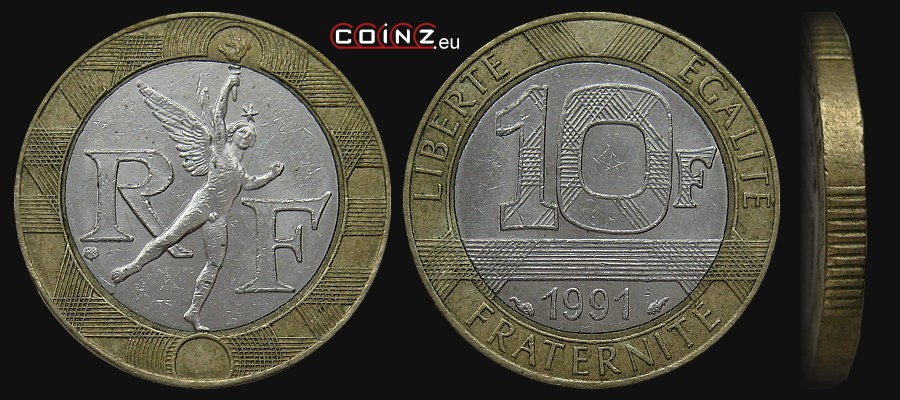
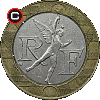
| diameter: | weight: | thickness: | alloy: |
| 23.0 mm | 6.5 g | 2.2 mm | Cu92Al6Ni2 / Ni |
obverse:
in the coin centre Génie de la Liberté - figure crowning the July Column (Place de la Bastille); in the background capital letters: RF (République Française - French Republic); outer ring decorated with parallel stripes
reverse:
in the coin centre face value: 10 F (FRANCS); below year of issue; along the top edge: LIBERTÉ ÉGALITÉ, along the bottom one: FRATERNITÉ (liberty, equality, fraternity); in the background banches of parallel stripes
edge:
five plain and five reeded sections
issue date:
??? no data
withdrawal date:
18 II 2002
designer:
Atelier de gravure (group of designers of the Paris Mint - rosette below letter R in the obverse)
mint:
 La Monnaie de Paris (The Paris Mint), Pessac (mint mark before year of issue in the reverse, after year of issue privy mark of mint's director Emile Rousseau - dolphin - in years 1988-1993, Pierre Rodier - bee - in years 1994-2000 or Gérard Buquoy - horseshoe - in 2001)
La Monnaie de Paris (The Paris Mint), Pessac (mint mark before year of issue in the reverse, after year of issue privy mark of mint's director Emile Rousseau - dolphin - in years 1988-1993, Pierre Rodier - bee - in years 1994-2000 or Gérard Buquoy - horseshoe - in 2001)
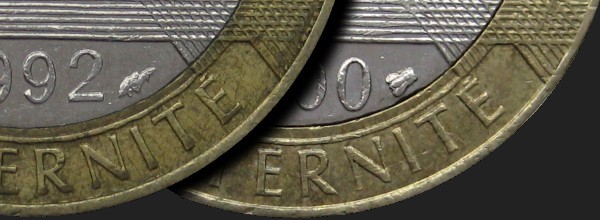
mintage:
| 1988 | 99 982 011 | dolphin | + 10 565 in annual boxed sets | |
| 1989 | 249 966 011 | dolphin | + 11 438 in annual boxed sets | |
| 1990 | 249 990 011 | dolphin | + 10 000 in annual boxed sets | |
| 1991 | 249 987 011 | dolphin | + 2 500 in annual boxed sets | |
| 1992 | 99 966 111 | dolphin | + 2 698 in annual boxed sets | |
| 1993 | - | dolphin | + 3 095 in annual boxed sets | medal alignment |
| 1994 | - | bee | + 3 707 in annual boxed sets | |
| 1995 | 15 011 | bee | + 4 000 in annual boxed sets | |
| 1996 | 12 013 | bee | + 5 000 in annual boxed sets | |
| 1997 | - | bee | + 15 000 in annual boxed sets | |
| 1998 | - | bee | + 25 000 in annual boxed sets | |
| 1999 | - | bee | + 25 000 in annual boxed sets | |
| 2000 | 27 956 013 | bee | + 100 000 in annual boxed sets | |
| 2001 | - | horseshoe | + 125 000 in annual boxed sets |
varieties:
1989 - 12 or 13 ridges in each reeded section of the edge;
in years 1991 and 1992 there exist coins with reverses not rotated by 180° in respect to obverses (medal alignment in American terminology) - 2 500 and 2 698 pieces were produced in respective years and placed in annual boxed sets
in years 1991 and 1992 there exist coins with reverses not rotated by 180° in respect to obverses (medal alignment in American terminology) - 2 500 and 2 698 pieces were produced in respective years and placed in annual boxed sets
mint marks:
interesting facts:
Isuue of year 1993 was completely struck in medal alignment and placed in annual boxed sets.
Le Génie de la Liberté by the sculptor Augustin-Alexandre Dumont from 1833 is crowning the July Column (La colonne de Juillet) on the Place de la Bastille in Paris.
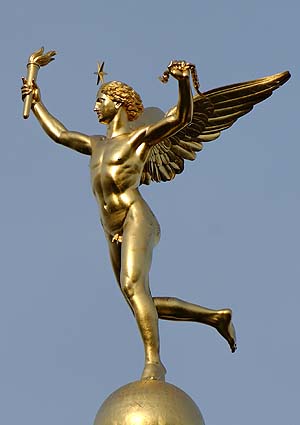
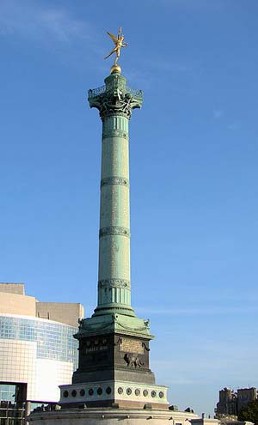
Le Génie de la Liberté by the sculptor Augustin-Alexandre Dumont from 1833 is crowning the July Column (La colonne de Juillet) on the Place de la Bastille in Paris.


last update: 20 XI 2013
coins catalogue :: katalog monet :: münzkatalog :: catalogue de monnaies :: catálogo de monedas :: catalogo monete :: каталог монет :: κέρματα κατάλογος :: COINZ.eu
© 2010-2025 :: Adam Kubicki :: COINZ.eu :: All rights reserved.


